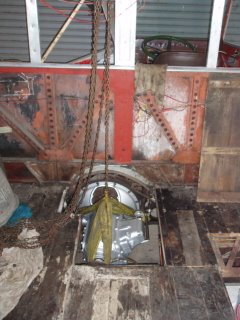En route to Smithfield and then back to Turramurra, a nasty noise was evident in the gearbox: a clicking sound in second gear. So the gearbox came out and was overhauled here using bits gleaned from another box of the type to make one good box out of two. Click on a photo to enlarge it.

USING THE CHAIN BLOCK AND EYE BOLT IN THE SOCKET THOUGHTFULLY PROVIDED BY THE BODY BUILDERS IN THE ROOF OF THE BOTTOM DECK, THE GEARBOX, SEPARATED FROM THE ENGINE, IS HOISTED CLEAR OF THE CHASSIS INTO THE LOWER SALOON

THE APERTURE PROVIDED IN THE FLOOR OF THE BOTTOM DECK IS NOT ENOUGH TO LIFT THE GEARBOX STRAIGHT UP: AFTER LOWERING IT TO THE FLOOR IT HAS BEEN SLUNG FROM ITS REAR FLANGE AND LIFTED ON END INTO THE LOWER SALOON. FROM THERE IT NEEDED TWO MEN TO CARRY IT OUT TO THE REAR PLATFORM TO THE WORKSHOP FOR DISMANTLING

WHILE STILL IN SITU, THE GEARBOX WAS DRAINED OF OIL AND THE SIDE PLATE REMOVED. NOW, OUT OF THE CHASSIS AND RESTING ON THE LOWER DECK FLOOR, THE PROBLEM IS REVEALED. THE CENTRE PORTION OF THIS TOOTH HAS A LARGE CHIP OUT OF IT, BY WHAT MEANS IS UNCERTAIN: BECAUSE THE CHIP IS NOT AT THE FRONT OF THE GEAR IT IS UNLIKELY TO BE ROUGH ENGAGEMENT.

AFTER STEAM CLEANING THIS BECAME APPARENT: THE DATE OF ASSEMBLY, 13th DECEMBER 1938. THE BOX IS THEREFORE FROM A LEYLAND TD5, BUT AS IT IS IDENTICAL TO A TD4 BOX, IT HAS BEEN TAKEN FROM THE STORES AND FITTED AT THE BUS'S LAST OVERHAUL IN 1955. Elsewhere, on the top of the case, three sets of initials are stamped, and a type number, GB9B, and a reference number, probably its serial number. It shows the pride in workmanship that the team of three responsible for final assembly of the box, just twelve days before Christmas in 1938, have identified their job, but it may also be a means for Leyland Motors Ltd to identify those responsible if that box should have given trouble under guarantee!

AFTER DISMANTLING, STEAM CLEANING AND REPLACEMENT OF DAMAGED OR WORN PARTS, THE GEARBOX IS REASSEMBLED

VIEW FROM THE REAR OF THE BOX, PRIOR TO REFITTING THE SELECTOR MECHANISM AND THE SIDE COVER PLATE

THE GEARBOX SLUNG FROM THE CHAIN BLOCK HAS BEEN MATED BACK TO THE ENGINE AND CLUTCH HOUSING. While the box was out the opportunity was used to dismantle clean and overhaul the clutch, which showed signs of having had a birds' nest in it! It was full of wisps of grass and fluff. The pressure plate was sent away for machining smooth, although for its age it was not in bad shape with some very minor surface crazing.

RESPLENDENT IN A COAT OF SILVER PAINT THE GEARBOX AND DRIVE ARE READY TO ROLL. We can't wait to find out how it sounds and whether the clutch brake behaves itself.
Answer: the gearbox is fine but the clutch brake now works so effectively that it makes the upward gear shift quite tricky; one has to shift very fast or else fluff the change altogether. The technique, as advised by Craig, is to shift by barely depressing the clutch pedal, moving to neutral, clutch up while engine revs die away to idle, then again barely depressing the clutch move to the next gear. In other words, don't use the clutch brake at all, which comes in when the pedal is fully depressed.
The newly refurbished drive then highlighted a second noise problem: a shudder from the prop shaft and quite noticeable vibration at road speed. After arrival at Loftus a quick scramble around under the bus revealed that the vibration damper ironically is the problem: it is loose on the shaft. This will require removal of the universal joint at the centre bearing mounted on the chassis cross-member about halfway along the shaft, to expose the large nut securing the damper. As it has been loose for some time there may be some minor wear on the tapered hub of the damper, but it will enable it to be inspected closely for wear in the friction linings, and refitted in a cleaned and painted condition. This will have to wait until painting is complete because the process needs the bus to kept mobile at all times.
No comments:
Post a Comment